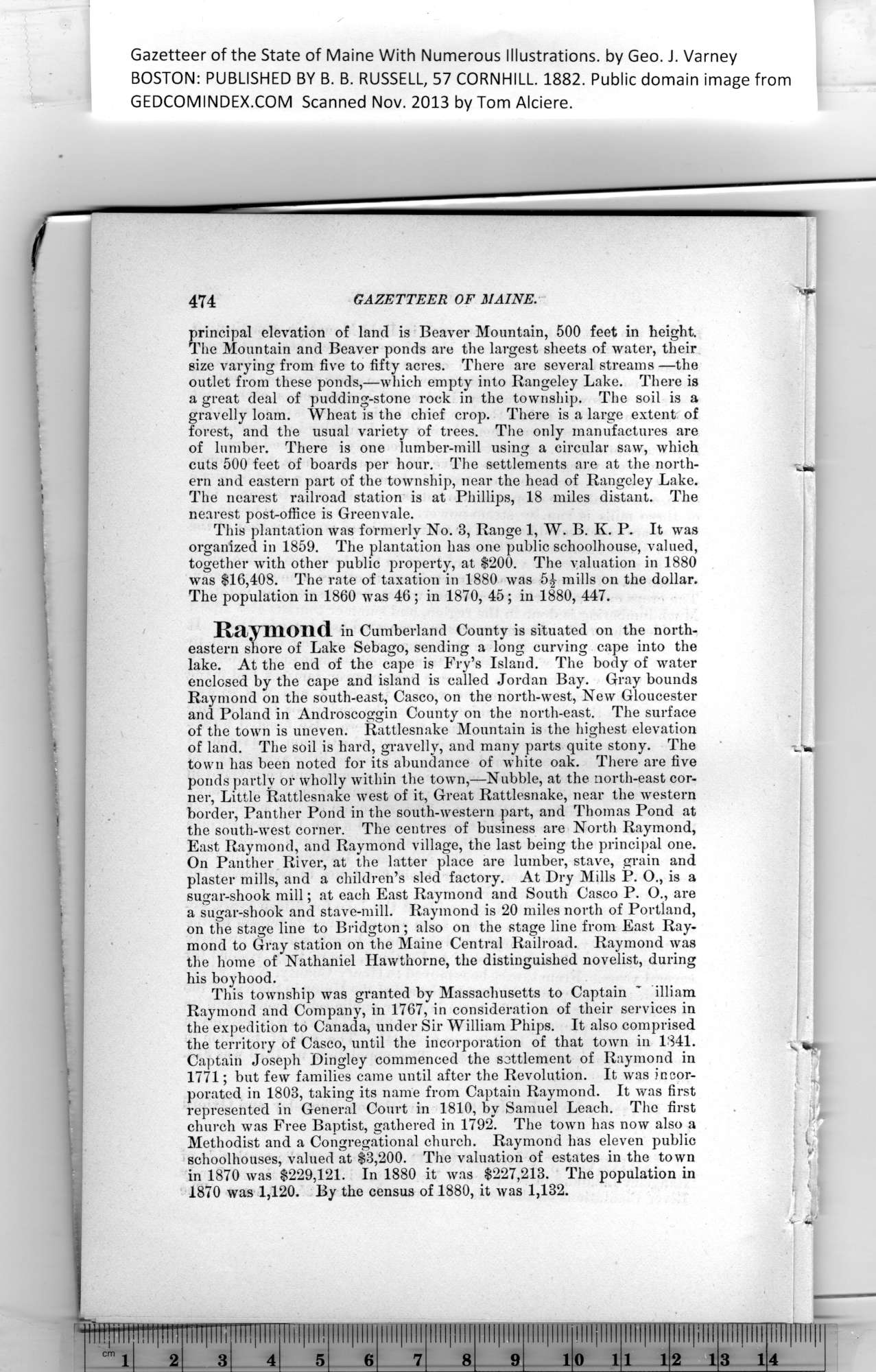|
Gazetteer of the State of Maine With Numerous Illustrations, by Geo. J. Varney
BOSTON: PUBLISHED BY B. B. RUSSELL, 57 CORNHILL. 1882. Public domain image from
principal elevation of land is Beaver Mountain, 500 feet in height.
The Mountain and Beaver ponds are the largest sheets of water, their
size varying from five to fifty acres. There are several streams —the
outlet from these ponds,—which empty into Rangeiey Lake. There is
a great deal of pudding-stone rock in the township. The soil is a
gravelly loam. Wheat is the chief crop. There is a large extent of
forest, and the usual variety of trees. The only manufactures are
of lumber. There is one lumber-mill using a circular saw, which
cuts 500 feet of boards per hour. The settlements are at the north-
ern and eastern part of the township, near the head of Rangeiey Lake.
The nearest railroad station is at Phillips, 18 miles distant. The
nearest post-office is Greenvale.
This plantation was formerly No. 3, Range 1, W. B. K. P. It was
organized in 1859. The plantation has one public schoolhouse, valued,
together with other public property, at $200. The valuation in 1880
was $16,408. The rate of taxation in 1880 was 5£ mills on the dollar.
The population in 1860 was 46; in 1870, 45; in 1880, 447.
Raymond in Cumberland County is situated on the north-
eastern shore of Lake Sebago, sending a long curving cape into the
lake. At the end of the cape is Fry’s Island. The body of water
enclosed by the cape and island is called Jordan Bay. Gray bounds
Raymond on the south-east, Casco, on the north-west, New Gloucester
and Poland in Androscoggin County on the north-east. The surface
of the town is uneven. Rattlesnake Mountain is the highest elevation
of land. The soil is hard, gravelly, and many parts quite stony. The
town has been noted for its abundance of white oak. There are five
ponds partly or wholly within the town,—Nubble, at the north-east cor-
ner, Little Rattlesnake west of it, Great Rattlesnake, near the western
border, Panther Pond in the south-western part, and Thomas Pond at
the south-west corner. The centres of business are North Raymond,
East Raymond, and Raymond village, the last being the principal one.
On Panther River, at the latter place are lumber, stave, grain and
plaster mills, and a children’s sled factory. At Dry Mills P. O., is a
sugar-shook mill; at each East Raymond and South Casco P. O., are
a sugar-shook and stave-mill. Raymond is 20 miles north of Portland,
on the stage line to Bridgton; also on the stage line from East Ray-
mond to Gray station on the Maine Central Railroad. Raymond was
the home of Nathaniel Hawthorne, the distinguished novelist, during
his boyhood.
This township was granted by Massachusetts to Captain ~ illiam
Raymond and Company, in 1767, in consideration of their services in
the expedition to Canada, under Sir William Phips. It also comprised
the territory of Casco, until the incorporation of that town in 1341.
Captain Joseph Dingley commenced the settlement of Raymond in
1771; but few families came until after the Revolution. It was incor-
porated in 1803, taking its name from Captain Raymond. It was first
represented in General Court in 1810, by Samuel Leach. The first
church was Free Baptist, gathered in 1792. The town has now also a
Methodist and a Congregational church. Raymond has eleven public 1
schoolhouses, valued at $3,200. The valuation of estates in the town ?
in 1870 was $229,121. In 1880 it was $227,213. The population in
1870 was 1,120. By the census of 1880, it was 1,132. *
PREVIOUS PAGE ... NEXT PAGE
This page was written in HTML using a program written in Python 3.2
|
